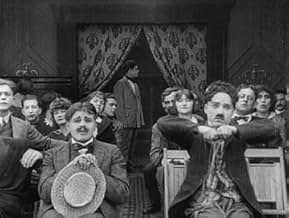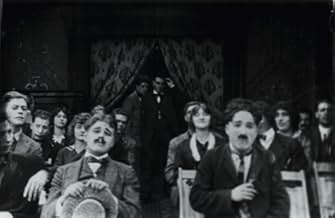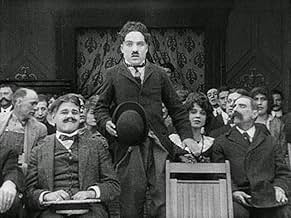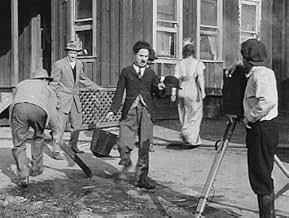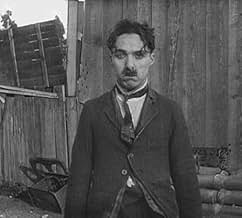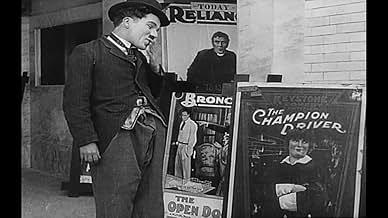PUNTUACIÓN EN IMDb
5,6/10
1,8 mil
TU PUNTUACIÓN
Añade un argumento en tu idiomaCharlie attempts to meet his favorite movie actress at the Keystone Studio, but does not win friends there.Charlie attempts to meet his favorite movie actress at the Keystone Studio, but does not win friends there.Charlie attempts to meet his favorite movie actress at the Keystone Studio, but does not win friends there.
- Dirección
- Guión
- Reparto principal
Dan Albert
- Audience Member
- (sin acreditar)
Hampton Del Ruth
- Lead Actor
- (sin acreditar)
Minta Durfee
- Self
- (sin acreditar)
- …
Billy Gilbert
- Theatre Usher
- (sin acreditar)
William Hauber
- Audience Member
- (sin acreditar)
Bert Hunn
- Audience Member
- (sin acreditar)
George Jeske
- Prop Boy in White Shirt
- (sin acreditar)
Edgar Kennedy
- Director
- (sin acreditar)
Sadie Lampe
- Audience Member
- (sin acreditar)
Henry Lehrman
- Self
- (sin acreditar)
Hank Mann
- Prop Boy in Overalls
- (sin acreditar)
Harry McCoy
- Fireman
- (sin acreditar)
- …
George Nichols
- Older Actor on Screen
- (sin acreditar)
Reseñas destacadas
Charles Chaplin plays an overly infatuated film fan who decides to visit a movie theatre after seeing a gorgeous actress on the poster. In theatre, he causes quite a havoc before he gets thrown out. Afterward, he manages to get inside the movie studio where he sees the girl from the poster and movie. Well, you guessed it, more havoc is caused.
The theme of a fan falling in love with a starlet is interesting. The plot is easy to follow, even though some scenes seem quite randomly put together. The most interesting part to me was of course the look inside The Keystone Studios and to see how the films were made back in the day. Chaplin's Tramp was still just a trouble maker, but perhaps here some of the more recognizable traits are becoming visible.
Chaotic but still amusing movie. One of the best from the early works of Charles Chaplin.
If anyone has a question about what the title means then it is a play with the term "stage door Johnnie" which was used to describe people who hang out near the theatres in hopes of meeting actors or even land a job in the theatre.
The theme of a fan falling in love with a starlet is interesting. The plot is easy to follow, even though some scenes seem quite randomly put together. The most interesting part to me was of course the look inside The Keystone Studios and to see how the films were made back in the day. Chaplin's Tramp was still just a trouble maker, but perhaps here some of the more recognizable traits are becoming visible.
Chaotic but still amusing movie. One of the best from the early works of Charles Chaplin.
If anyone has a question about what the title means then it is a play with the term "stage door Johnnie" which was used to describe people who hang out near the theatres in hopes of meeting actors or even land a job in the theatre.
According to some of the central figures involved, including Charlie Chaplin and producer Mack Sennett, Chaplin's first weeks making movies at the Keystone Studio were not pleasant ones. No one knew what to make of this temperamental young Englishman, while Chaplin, for his part, was bewildered by film technique and didn't get along with his colleagues. Though it may seem hard to believe now, there were serious doubts all around that Chaplin could make good in the movies.
Viewed in this light Chaplin's fifth comedy, A Film Johnnie, a fairly amusing short in its own right, takes on some additional historical weight as something of an inside joke, an indirect comment on Chaplin's actual off-screen status at his studio. In the opening sequence a scruffy-looking Charlie goes into a cinema and sees a Keystone comedy featuring an actress he admires. When her co-star, an older man, gets fresh with her Charlie becomes so upset and agitated he is ejected from the theater. He heads straight to the Keystone Studio, seeking to get in. (Thus the title: he's like the "stage door johnnies" who would hang around theaters, hoping to meet the performers and/or get a job with the acting company.) He watches as prominent performers such as Roscoe Arbuckle and Ford Sterling, wearing their street garb, step out of cars and casually enter the studio, smiling and chatting. They're members of the In Crowd, but he is not. Approaching a bemused Arbuckle, he requests and receives a hand-out. He tries this again with Sterling, but -- in a reflection of their alleged off-camera friction? -- receives nothing; Sterling even takes the coin Arbuckle had given Charlie earlier. The studio director (Edgar Kennedy) refuses Charlie admission, but he easily slips past the elderly doorman. Once inside he finds the girl he so admires (Virginia Kirtley) but ruins the scene she's acting in because he believes it's actually happening. He runs amok with a prop pistol, scaring everyone, then leaves.
The comic mayhem that occurs in the studio and at a nearby house fire --which might have been a real event-- amounts to routine Keystone knockabout, apparently improvised while the cameras were rolling. Charlie contributes some cute gags: he lights a cigarette by shooting it with a pistol, and starts to kick a stage hand but when the man turns he quickly switches to scratching his ankle. What's really of interest here is the context and the subtext: essentially Chaplin was still on probation when this film was made, and his colleagues' wariness towards him appears to be genuine. A Film Johnnie captures a time when Charlie hadn't made the grade, just yet.
Viewed in this light Chaplin's fifth comedy, A Film Johnnie, a fairly amusing short in its own right, takes on some additional historical weight as something of an inside joke, an indirect comment on Chaplin's actual off-screen status at his studio. In the opening sequence a scruffy-looking Charlie goes into a cinema and sees a Keystone comedy featuring an actress he admires. When her co-star, an older man, gets fresh with her Charlie becomes so upset and agitated he is ejected from the theater. He heads straight to the Keystone Studio, seeking to get in. (Thus the title: he's like the "stage door johnnies" who would hang around theaters, hoping to meet the performers and/or get a job with the acting company.) He watches as prominent performers such as Roscoe Arbuckle and Ford Sterling, wearing their street garb, step out of cars and casually enter the studio, smiling and chatting. They're members of the In Crowd, but he is not. Approaching a bemused Arbuckle, he requests and receives a hand-out. He tries this again with Sterling, but -- in a reflection of their alleged off-camera friction? -- receives nothing; Sterling even takes the coin Arbuckle had given Charlie earlier. The studio director (Edgar Kennedy) refuses Charlie admission, but he easily slips past the elderly doorman. Once inside he finds the girl he so admires (Virginia Kirtley) but ruins the scene she's acting in because he believes it's actually happening. He runs amok with a prop pistol, scaring everyone, then leaves.
The comic mayhem that occurs in the studio and at a nearby house fire --which might have been a real event-- amounts to routine Keystone knockabout, apparently improvised while the cameras were rolling. Charlie contributes some cute gags: he lights a cigarette by shooting it with a pistol, and starts to kick a stage hand but when the man turns he quickly switches to scratching his ankle. What's really of interest here is the context and the subtext: essentially Chaplin was still on probation when this film was made, and his colleagues' wariness towards him appears to be genuine. A Film Johnnie captures a time when Charlie hadn't made the grade, just yet.
7tavm
Just watched on the Internet Archive site 8 minutes of what this site states was a 15 minute short made by Mack Sennett's Keystone Studios. It stars Charlie Chaplin in another of his early appearances in which he's at that studio, as a civilian in his Tramp costume, wreaking havoc. If I didn't read the synopsis here beforehand, I would have been partly confused as to what was going on but because of that, I laughed at the part where he came to the "rescue" of his lady crush when she was being "attacked" and when he used the gun to kill her "attacker". Also, was that the first time that gun was used to light a cigarette? Was marred a bit by blurry titles and, once again, missing beginning context. Still, I was quite fascinated by what I saw of A Film Johnnie. Update-6/14/11: I just watched the entire thing on YouTube with the original Keystone titles intact. It's now a bit funnier so I'm now upping the rating from 5 to 7.
Edgar English's work in this picture will keep it amusing. There are many good situations, fresh and laughable, and the offering ought to be welcome everywhere as a Tightener of the program. Camera work helps a lot. - The Moving Picture World, March 7, 1914
Short (about 7 minutes) comedy featuring Charlie Chaplin as a movie fan on the set of a movie. Charlie is unable to see the difference between on screen acting and the real life, so when his favorite actress gets 'attacked' he tries to rescue her.
Then there's a great scene in which he lights his cigarette with his gun, but unfortunately he's starting a fire with it. The movie executives try to make the best of it by shooting another scene, until Charlie is standing in the way yet again...
Amusing little flick and a must-see for every Charlie fan, although not among his best or most important shorts from that era. 6/10.
Then there's a great scene in which he lights his cigarette with his gun, but unfortunately he's starting a fire with it. The movie executives try to make the best of it by shooting another scene, until Charlie is standing in the way yet again...
Amusing little flick and a must-see for every Charlie fan, although not among his best or most important shorts from that era. 6/10.
¿Sabías que...?
- CuriosidadesAlthough some sources credit Mack Sennett with playing himself, the film director, the role is actually played by Edgar Kennedy--who, besides being a comic actor, was also a respected director.
- PifiasMembers of the audience behind Charlie Chaplin change - for example, Minta Durfee is sitting behind Chaplin in some shots, but a different actress is seated behind him in others.
- Versiones alternativas1930s reissue version, entitled Film Johnny, (released on DVD) omits the opening sequence in the movie theater.
- ConexionesFeatured in Crazy Days (1962)
Selecciones populares
Inicia sesión para calificar y añadir a tu lista para recibir recomendaciones personalizadas
Detalles
- Fecha de lanzamiento
- País de origen
- Sitios oficiales
- Idiomas
- Títulos en diferentes países
- A Film Johnnie
- Localizaciones del rodaje
- Bryson Apartments, 2701 Wilshire Blvd., Los Ángeles, California, Estados Unidos(Apartment Building)
- Empresa productora
- Ver más compañías en los créditos en IMDbPro
- Duración15 minutos
- Color
- Mezcla de sonido
- Relación de aspecto
- 1.33 : 1
Contribuir a esta página
Sugerir un cambio o añadir el contenido que falta

